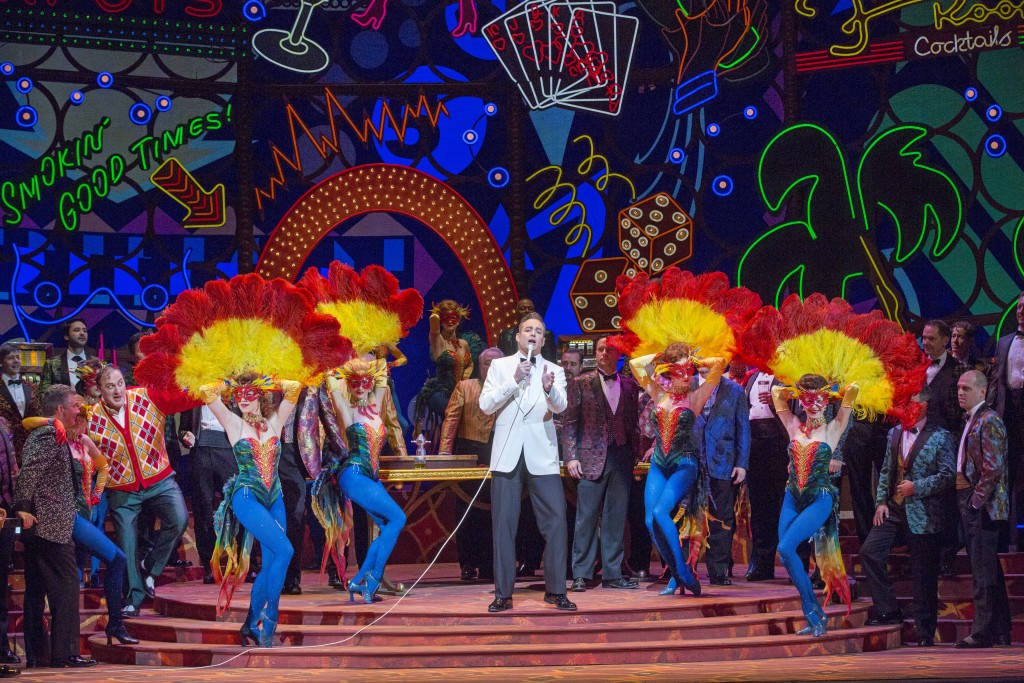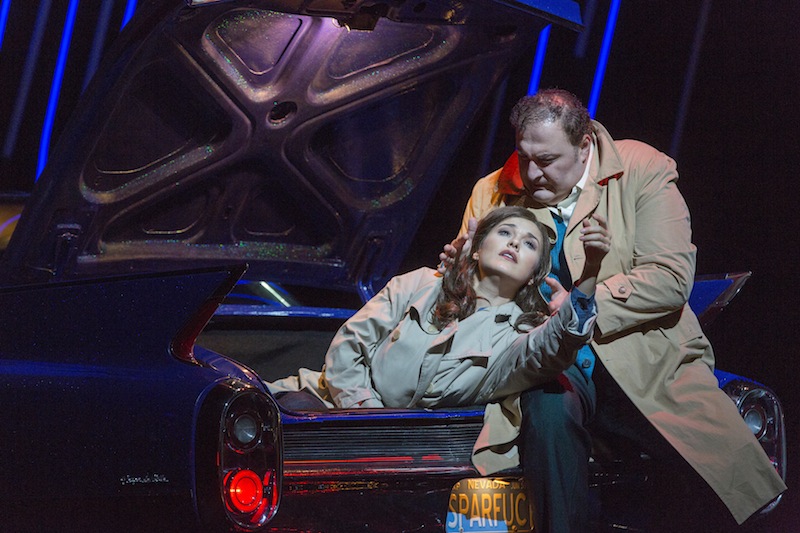Met’s mobbed-up “Rigoletto” shines even more brilliantly the third time around

Stephen Costello as the Duke in the Metropolitan Opera production of Verdi’s “Rigoletto.” Photo: Richard Termine
Rigoletto is back at the Metropolitan Opera in Michael Mayer’s production that sets the story in mid-twentieth century Las Vegas. This revival, which opened Tuesday night, is one of the great successes of the Peter Gelb era.
The third time around, this production seems better than ever. With its seedy red backlighting, green velvet curtains, neon, stag-party like chorus in costume designer Susan Hilferty’s patterned dinner jackets, the stage explodes with style—the audience spontaneously applauded Christine Jones’ set the instant the lights went up.
The production is even more substantive, enough so that familiarity means discovering new details, new depths, new ideas that turn Verdi’s great pessimistic targedy into an experience that makes the art of the past meaningful for contemporary audiences.
The cast in this year’s production adds to Mayer’s concept, especially tenor Stephen Costello as the Duke. Costello is a fine Verdian tenor, with an ideal range and a rounded, colorful sound (once he warmed up, which he did quickly). Costello also used touches of rubato to give his phrases the conversational quality, essential to Verdi singing. Other tenors may surpass him in terms of sheer beauty, but Costello sang the character, who must be attractive and repellent at the same time, beautifully.
In his white dinner jacket, lounging around with a louche, narcissistic confidence, he was the personification of Johnny Fontane from The Godfather, the production sparking a cache of cultural memory and meaning.
When Rigoletto (baritone George Gagnidze) first meets Sparafucile (bass Štefan Kocán) in a bar, the scene could be from the cover for a Sinatra/Nelson Riddle album, or from one of the songs inside. These vivid images made the secondary characters and chorus into more than just an entourage—they are a menacing cohort of petty crooks, creeps, and sociopaths. They are faceless and monolithic, and tell a story about how dangerous lonely, middle-aged men can be. In the context of the Mob (and the mob), murder is a logical response to deep, personal violations.
Gagnidze is a natural as Rigoletto. No hunchback, he towered over everyone else in the cast except for Kocan. Gagnidze has been a strong Scarpia in the past, with an aura of gleeful malevolence, and that same quality, turned on its side, shows him as a natural clown, of the vicious variety. He sang with an aggressive edge to his voice, even in his lament “Quel vecchio maledivami.” At his most human, the first Act duet with his daughter Gilda, Gagnidze sang with a warm, expressive tone.
But in this performance the character was always the protagonist, never a hero. When Rigoletto, in Act II, begs to know about the whereabouts of his daughter Gilda, he was truly pathetic. Gagnidze’s groveling and bluster couldn’t conceal his insecurity about his place among the Duke’s men, and that made his turn to vengeance and murder cut deep, dramatically.

George Gagnidze in the title role and Olga Peretyatko as Gilda in “Rigoletto.” Photo:
Richard Termine
Gilda was sung by soprano Olga Peretyatko. Her clear voice has a girlish quality, with plenty of substance, and she handled the extremes of range with modest effort. It was pure pleasure to hear her singing “Figlia/Mio padre!” The combination of Cotello’s voice and presence made a real impression on her character in “E il so dell’anima,” and when she sang “Gaultier Maldè,” one was genuinely convinced of her feelings, which turned the Act III climax from potential contrivance into emotional reality.
Kocán’s crisp, resonant voice cut through everything, fundamental to the ominous quality he brought to the assassin. He held his low F at the close of “Par siamo” for a stylish eternity—technically impressive, but also a sign that the character considers himself better than those he murders, disdainful vocalism.
Bass Stefan Szkafarowsky, sang the part of Monterone with his own sinister weight, tossing off every phrase like an epithet and a threat. Mezzo-soprano Katarina Leoson, making her Met Opera debut, was a sexy and dangerous Maddalena.
Like Costello, the orchestra and conductor Pablo Heras-Casado needed a bit of warming up. Some phrases, attacks, and tempos in the first Act were mushy, but once Rigoletto and Sparafucile meet, the playing was seamless. As he did last season, Heras-Casado led the musicians with a finely judged forward line—the action in this opera can seem to hurtle along, but Tuesday night everything fell into place with a sense of inexorable foreboding. The orchestra played with a pleasantly lean, Verdian sound.
This Rigoletto is one of the bright spots of the current Metropolitan Opera. This production should remain in steady rotation for as long as people listen to Sinatra, watch movies, and go to Las Vegas.
Rigoletto continues at the Metropolitan Opera through December 17. Željko Lučić sings the title role, and Piotr Beczala the Duke, starting November 13, and Nadine Sierra sings Gilda from December 2 metopera.org.







Posted Oct 24, 2015 at 3:30 am by Marina Boagno
If this is Verdi’s Rigoletto I am Queen Cleopatra